An Inland Voyage Revisited
A gray sky, and a river the color of silver: the morning is above all dreary. Enormous barges and small freighters disturb the calm of the Escaut River estuary. Tugboats come and go, some toward a liner ready to depart, others toward busy wharves in the harbor. Two leave the right bank at downtown Anvers, and are snatched up by the tide’s flood and carried upstream. On board, we are pleased this voyage we’ve imagined for a decade is now underway.
For my companion—Jean-Marie Huron—the exhilaration is short-lived: his kayak, VAILIMA, insists on veering to the right. I had many occasions to try mine, SILVERADO, but Jean-Marie didn’t board for the first time until the day before departure. The prospect of constantly adjusting his course for three weeks was more than depressing.
The route we intended to complete was Antwerp in northern Belgium to Pontoise on the outskirts of Paris via the rivers and canals. It had been completed 1876 by the writer Robert Louis Stevenson and his friend Walter Simpson. The future author of Treasure Island was then 27 years old and had reached a crossroads in his life. Although he wished to make his living as a writer, he acceded to his father’s insistence that he work as a lawyer in London. To escape this destiny, the young Scotsman saw only one way forward: to publish a book and hope that its success would be enough to sway his father.
He followed suit with what was a flourishing genre of the time: river adventure. The initial destination the two companions chose was Grez-sur-Loing, near Fontainebleau, where they could meet up with young impressionist painters—a merry group that included Fanny Van de Grift, a woman the writer had encountered some months earlier and for whom he had fallen head over heels.
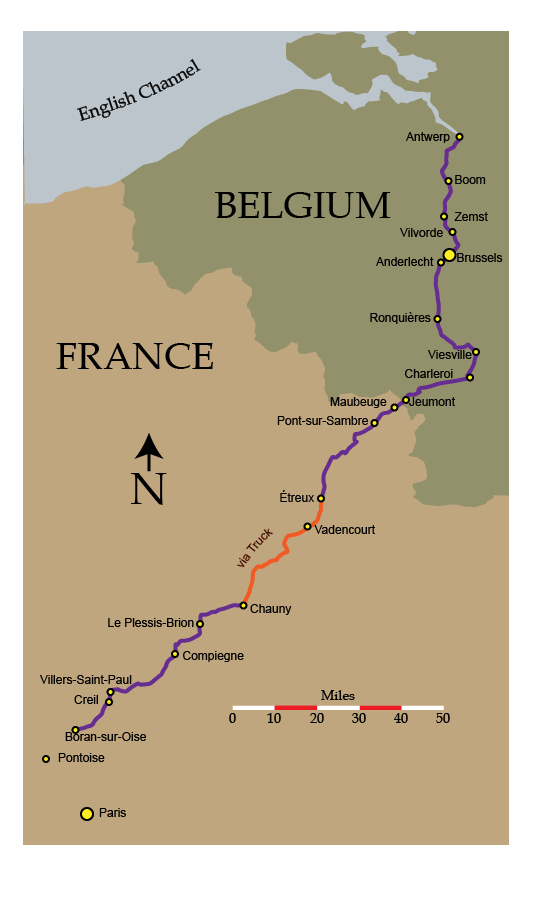 Two aspects of An Inland Voyage, the book that Stevenson published about the voyage, touched me immediately: first, the course, which I found wonderful and even exotic despite its geographic proximity to my home in Bordeaux; and, second, its vagabond spirit, which struck me as reawakening an ethic of leaving much to chance, a dance with luck, relying on unplanned encounters and unfolding episodes.
Two aspects of An Inland Voyage, the book that Stevenson published about the voyage, touched me immediately: first, the course, which I found wonderful and even exotic despite its geographic proximity to my home in Bordeaux; and, second, its vagabond spirit, which struck me as reawakening an ethic of leaving much to chance, a dance with luck, relying on unplanned encounters and unfolding episodes.
As we paddled away from Antwerp, two workers in fluorescent orange vests hailed us from a high bank above the Escaut River: “Where are you going?” I would have responded, “Pontoise,” but Jean-Marie was more convincing: “Paris!” “Ah, Paris!” came the reply from above, “It’s beautiful, right? Like Antwerp, the capital of Belgium!”
Welcome to Flanders—where Flemish northern pride takes precedence over allegiance to Brussels in the south. We spent most of the day paddling in the busy Escaut and enjoyed the turn in the quiet river Rupel. Our plan was to stop in the city of Boom as our predecessors did. But as we found no place to disembark, we decided to try the lovely village standing on the other bank. Amusingly, our kayaks were housed for the night in a boatyard that specializes in high-speed motorboats.
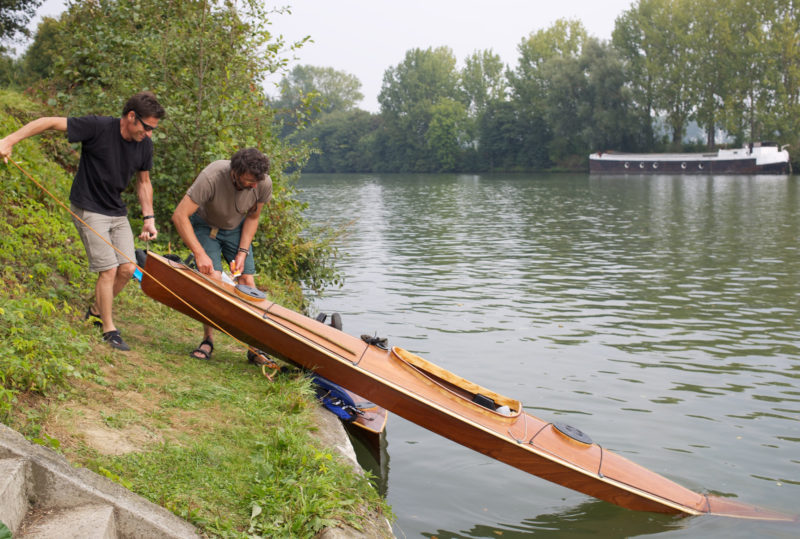 All photographs by Jean-Marie Huron
All photographs by Jean-Marie HuronGetting back to the water, as here in Verberie, France, was often challenging.
The second day started with an exhausting portage around the lock at Zemst. To clear that 27′ rise, we had to haul, pull, and push, grabbing alder branches and tufts of thorny weeds in our bare hands; then, to put in again, go under the astonished eyes of wizened fishermen lined up above—all this backbreaking work only to learn, a few minutes later, that the guardians of this fortress would have opened their gates, if we had only dared to ask them.
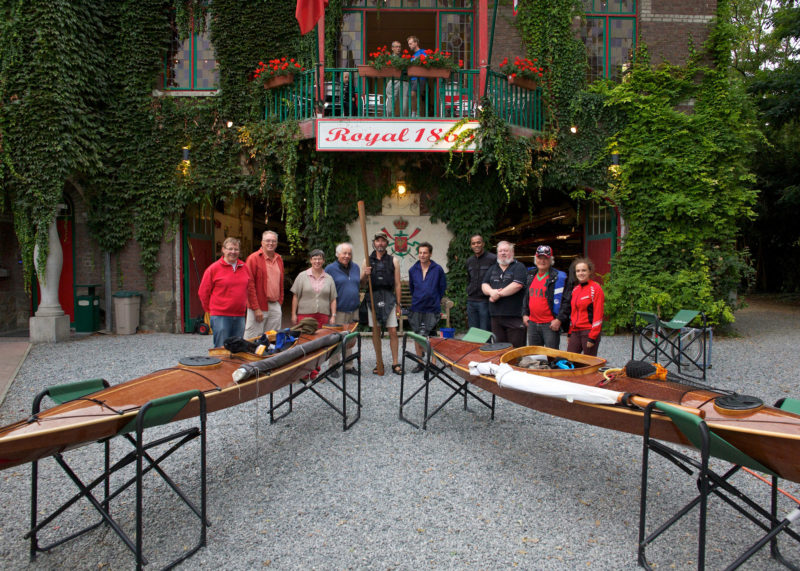
The welcome at the Royal Sport Nautique of Brussels, Belgium, was an enthusiastic one.
We landed at a float in front of the Royal Sport Nautique of Brussels, where a dozen club members awaited us. We had hardly disembarked before our kayaks were hauled out of the water, carried across the club’s graveled courtyard, placed on gentle cradles, washed, rinsed in fresh water, polished with soft cloths, photographed in front of the vine-covered façade, and, at last, sheltered in the vast boat shed among the club’s shells and skiffs.
Showers, dinner, and beds were all so rapidly organized that I could not help thinking of our predecessors and how their evening at Royal Sport Nautique degenerated. At first overjoyed by the good fortune of being celebrated by their Belgian hosts, they ended up being irritated by their obsessive attention. Were we to have an onslaught of questions about French rowing or kayaks, clubs, and champions, its waterways, its competitions? Would dinner turn into a nightmare?
As it happened we were only slightly interesting to the young athletes who stopped at the bar after their arduous training. Jean-Marie and I hadn’t been 20 years old for at least 20 years, so we talked with the elders, their trainers and managers. We spoke of the voyage, of the evolution of the Flemish language, of the intractable Belgian government. Of the Vilvorde, also, the industrial center whose riverbank we had traveled along just before our arrival. “The traumatic closure of the Renault factory in 1997 was a blow,” explained Marc Legein, the quiet, friendly president of the rowing program. The fallow industry has opened the way to gentrification and enticed oarsmen with water less toxic and air less nasty.
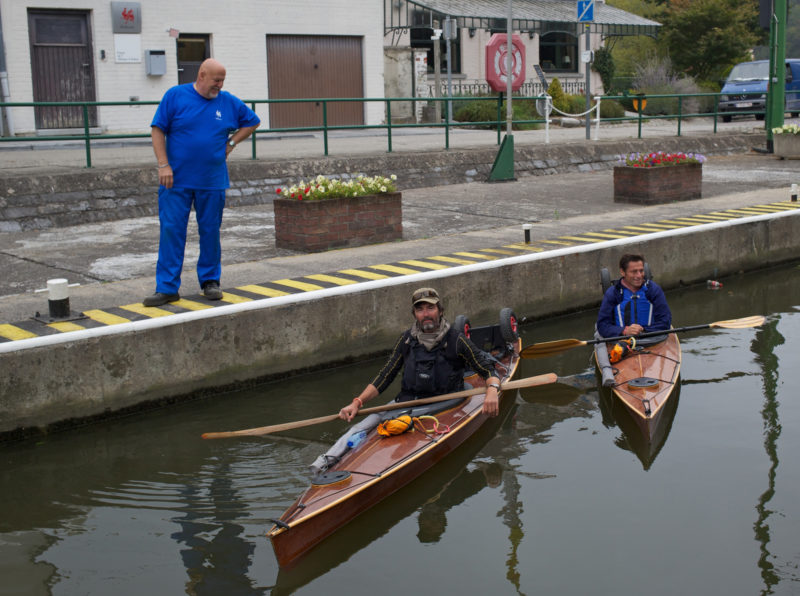
At Abbaye de l’Aulne, Belgium, the canal of the Sambre is served by very small locks.
We did not escape, however, our hosts’ curiosity about our kayaks. The idea to make these specialized boats for the project came from the documentary filmmaker Florent the La Tullaye, with whom I was originally intending to do the voyage. But it was only when I encountered Jean-Baptiste Bossuet, and discovered his boatyard, that making the boats became essential to the project. The man comes across as a little surly, but he is direct and honest when giving his opinion, full of passion when it comes to describing the art of building a performance sailboat. Though solidly anchored in a tradition founded six generations earlier, Jean-Baptiste is no less open to innovation. “Those who came before me were always searching for the most effective techniques of their times,” he insists. “I was raised that way.” On my visit to the boatyard, situated at the entrance to the Bay of Arcachon on France’s southern Atlantic coast, I was taken with this wooden shed full of tools, shavings, and all sorts of sounds from saws, mallets, surfacing machines, radio and even the ducks that Jean-Baptiste raises. For my objective—the kayaks—all that remained was to convince the guardian of this temple. His response was tepid. There was a bit of suspense, but finally, we reached agreement: “Let’s go!”
After several attempts to stow gear on VAILIMA’s deck and in her two watertight compartments, Jean-Marie found the right combination. With a little less weight forward, his kayak tracked as well as mine. We slipped away late that morning, and it was nearly noon when we reached Brussels. The waterway was constrained by two high quays allowing no access to the city. We had to content ourselves with waves of dirty water reflecting off the graffiti-covered walls until we reached the first lock. We called the lockmasters: they would open for us but asked if we would go aboard the SAINT JEAN BOSCO, a barge that was behind us. The lock could not take all three boats, and the mariner was in a hurry. Doubly raised by the passage through the lock and by the height of the barge, we could finally see the Belgian capital.
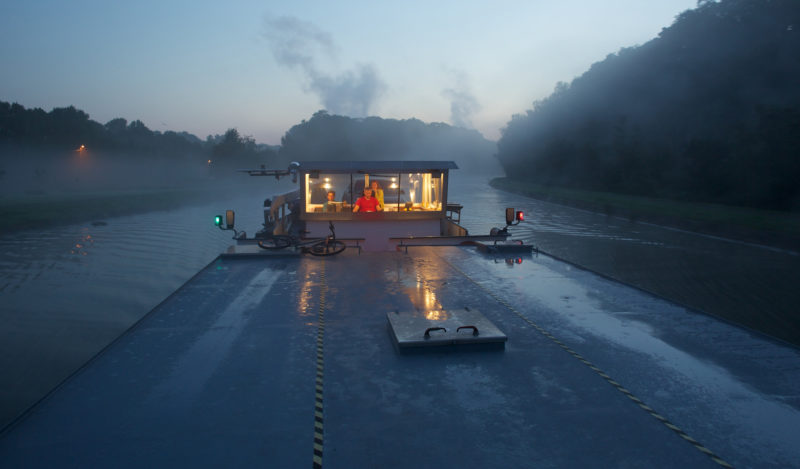
The barge SAINT JEAN BOSCO got an early-morning start heading for Seneffe, Belgium, with a load Chinese silicone.
Our host asked: “Why not stay aboard until the next lock, or even farther if you like, until the inclined lock at Ronquières?” We didn’t hesitate long. The prospect of climbing 68 meters of slope aboard SAINT JEAN BOSCO, itself hauled in an imposing moving tank mounted on 600 wheels, was too tempting to resist.
The afternoon was sunny. We passed Anderlecht, a suburb in the countryside. From time to time, a small town, a group of windmills, or a factory came in view of the canal. Aboard the barge we came to know Valerie Rigole—daughter, granddaughter, great-granddaughter, and sister of Belgian mariners—and her husband, Matthieu, from Bordeaux. “When our daughter Lana was born,” Valerie recalled, “we were working at a campground. We enjoyed the work, but it was demanding and incompatible with the time we wanted to spend with our child. So we decided to get licensed as river captains.”
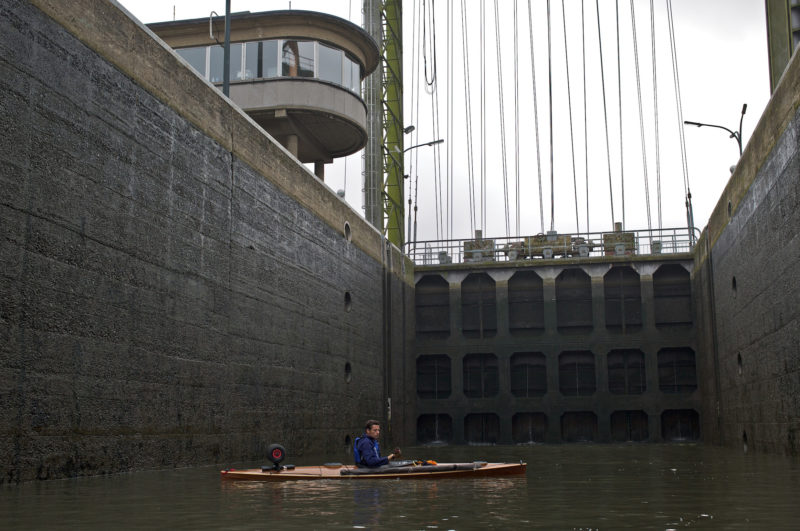
Aboard SILVERADO, Donatien waited for gates to open in the impressive lock at Marchienne, Belgium.
A lock approached. Matthieu bounded forward to prepare the mooring lines. I was taken with this quickness, which didn’t match my preconception of canal transport. “My family laughs at me,” Matthieu says, “They often say, ‘You are hyperactive and you live at 10 kilometers per hour.’ Aboard SAINT JEAN BOSCO there is always something to keep me busy, things to learn, I am always calculating and keeping myself informed.”
In the evening, a large plate of carbonara was the payoff for kilometers covered…without paddling. In the saloon, with its clean white partitions and its modern settee, Lana watched a Disney film on the flat-screen TV. We were far from Stevenson’s depictions of working life on the canals, but soon, as I was reading my hosts a passage from An Inland Voyage that evokes the peaceful life of mariners, Valerie exclaimed: “It’s exactly that! It’s in the photos of my grandmother, with the clothes drying on the line, the little mutt dogs, the flowers, the draft horses.”
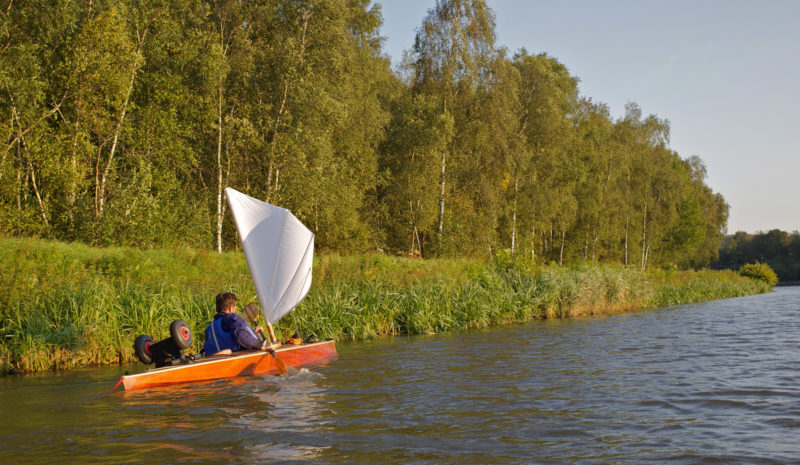
A gentle breeze on the canal from Brussels to Charleroi provided an opportunity for SILVERADO (here) and VAILIMA to set sail and race.
The next day SAINT JEAN BOSCO was moored in front of the bucolic Central Canal, and we parted. We set out in the beautiful glow of a late-summer day, and wound through river bends amid pastoral and level countryside until we came to a long stretch lined by reeds and framed by wooded hills. A slight breeze was at our backs—an ideal time for sailing. I slipped the mast into its sleeve and set the battened sail up. The race was on. VAILIMA and SILVERADO, named after places Stevenson had visited, vied for the lead. Gaining from the slightest puff, playing the eddies to the utmost, SILVERADO edged ahead and but for the treachery of a bank ahead and the insidious backwash of fast-moving barge, my victory would have been certain.
Coming up on the Viesville lock I furled the sail round the mast, slipped its gray cloth cover over it, and put it in its place on deck. We “knocked at the door” of the lock, but it was shut tight for the night. We turned back and chose a copse of birches for our first bivouac.
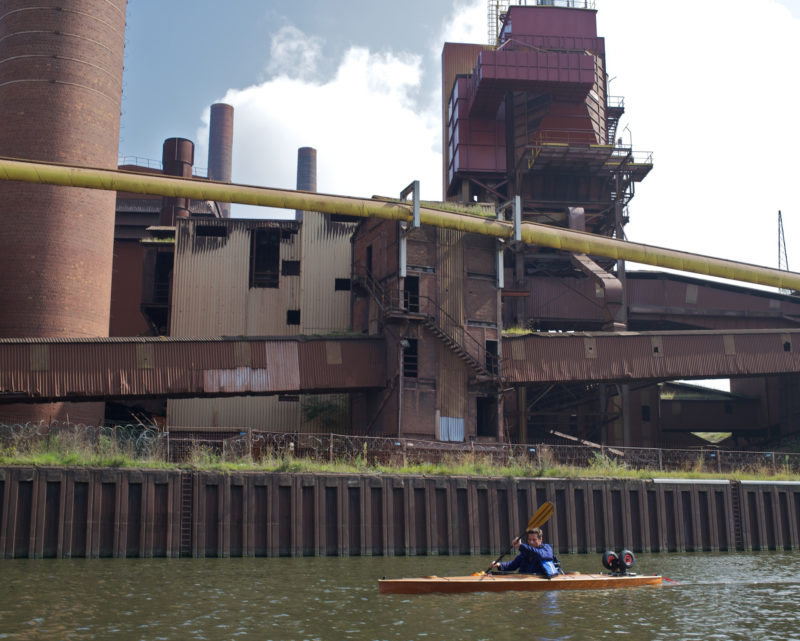
For centuries Charleroi thrived on coal, glass, and steel. The factories survived World War II but the industry fell into decline in the years that followed. Rusting and idle, the factories are eerily quiet.
Ahead lay the ghostly industrial complex of Charleroi, the Sambre canal system, and the French border at Jeumont. Stevenson and his friend, put off by the number of locks, the frequent delays caused by river traffic, and the incessant rain since their departure, decided to take a train from Brussels toward Maubeuge, but we kept on paddling.
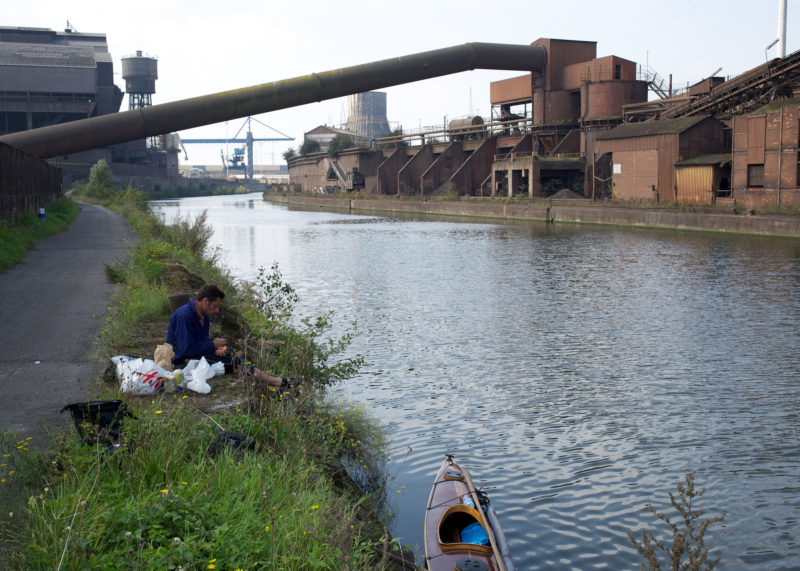
Most of the heavy industry in Charleroi appeared to be closed. The banks of the Sambre River made a ghostly picnic.
We arrived at the village of Pont-sur-Sambre, presenting, as Stevenson put it, “a most dubious sample of civilization.” We were dirty and tired. Jean-Marie had fallen first thing in the morning and had suffered a bruise. Our equipment was scarcely better. A bit of the brass stem band on VAILIMA had broken during a tight turn at a lock, and one of our portage carts was broken. Eight days out, we needed a break. We had, fortunately, been in touch with Michel Detrait, the mayor of Pont-sur-Sambre. We phoned him in the morning, and upon our arrival, his family–if not the whole village–was waiting for us, ready to help. At the grand brick house of Myriam and Michel Detrait, the dinner—a fondue of organic beef accompanied by chips and a cheesecake— was the beginning of our recuperation.
We were a very different team–shaved, showered, laundered, and restored by sleep–when we left the next afternoon. The day was made for boating. Under a blue sky I paddled in silence, following the track left by VAILIMA in water covered with yellow pollen.
The closure, in 2006, of the canal bridge at Vadencourt made it impossible to go all the way to Paris, avoiding the Central Canal, as the canal from Sambre to Oise has become a cul-de-sac. We went by truck from Étreux to Chauny and there rejoined the Oise. The absence of rain, while a welcome contrast to the incessant showers our predecessors suffered through, prevented us from launching at Vadencourt as there was not enough water in the river there for navigation. Downstream we confronted barriers of branches and rubbish, quagmires held by obstinate cattle, but soon enjoyed a string of the most sinuous and wild river bends we had seen since Anvers. An avid trout fisherman, Jean-Marie delighted in the outbreak of flies and the frequent strikes off his bow. For my part, I enjoyed the river scallops in the shallows, the escort by pair of green sandpipers, the bullet trajectory of martin-fishers, and a heron’s first try at flight.
The light was declining, the mist was gathering, and it was time to find a refuge. Ahead we saw above the alders and willows the pointed towers of a small Renaissance chateau. After arriving at the chateau du Plessis-Brion, the caretakers, Loic and Laetitia Marquet, put us up in their cottage. That evening we discussed stags, wild boars, and fox terriers while sipping a fine whisky.
The morning mist had not yet lifted when we started off. At the confluence of the Saint-Quentin and Aisne canal, the Oise becomes a river again. Barges passed us at full speed seemingly without seeing us, and industrial equipment and silos lined the banks. We passed Compiegne, then arrived two days later, in a drizzle, at Creil. At a bend of the river above Villers-Saint-Paul, we encountered Jean-Baptiste Fléret and Étienne Pillier, training in their rowing skiff. With their white outfits and their youth, they wouldn’t be out of place on a rowing team at Oxford in Stevenson’s time. Following their directions, we put in at the Étoile Nautique de l’Oise where they promised a secure place for our kayaks.
Situated on an island in the middle of Creil, the once splendid club seemed to be collapsing with the city, a victim of lost industry. That didn’t diminish at all the beautiful camaraderie of the oarsmen who gathered around us and admired our kayaks just as the oarsman at the Royal in Brussels had done. We were even saluted by some drunkards sprawled with their dogs under the willows on the opposite bank. After the oarsmen helped get our boats settled, the boat warden, a beekeeper, and several others complimented our kayaks on their great speed and their lustrous varnished mahogany. We soon found ourselves in a McDonald’s in a commercial zone with the two handsome oarsmen we had encountered on the water.
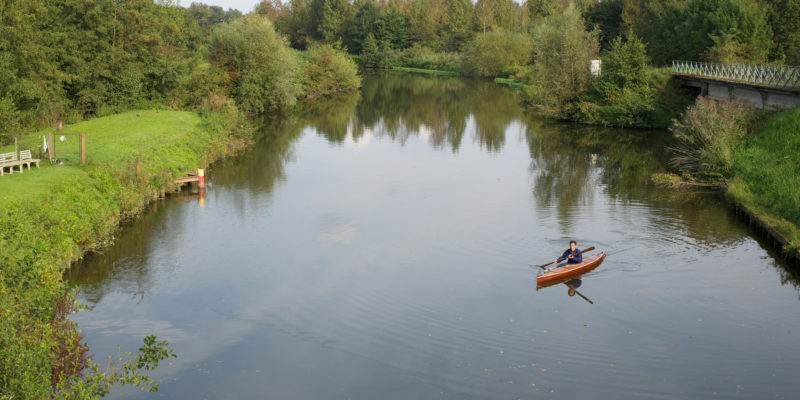
Near the village of Sassegnies, France, the Sambre meanders through farmlands and forests. The lock here was closed and we had to portage around it.
The next day, our 17th day, would be the last. All night, among the weights, the dumbbells, and other implements of sports torture scattered around the workout room of the Étoile, I tried in vain to sleep. One question, among them all, persisted: Where would we stop? At Pontoise? That seemed improbable given the distance yet to go. At Auvers-sur-Oise? The idea appealed to me for the connection with Grez-sur-Loing, which was Stevenson’s initial destination—and the one he and Simpson finally attained after abandoning their kayaks at Pontoise.
We woke up early determined to go as far as we could. It was around noon when we reached the lock at Boran-sur-Oise. But despite our insistence, the gatekeeper would not accept to let us in and no mariner would give us the lift we needed. We took it as fate, as it was clear that we had no energy left to haul our kayaks onshore and that the good luck that had followed us during our entire trip had run out.
We had a look at the small village of Boran-sur-Oise. Except for a strange abandoned nautical stadium from the 1950s at its entrance and a kebab restaurant in one of its few streets, it appeared to have remained the same since the 19th century. With its ever-present line fishermen, its willows, and its bell tower, we decided, with a glass of champagne, that it was not a bad place to end our humble voyage in the wake of young Robert Louis Stevenson.![]()
As a journalist and a writer, Donatien Garnier was part of the Argos Collective, a group of French photographers, writers, and cartoonists dedicated to documentary journalism. After 10 years of focusing on seafarers, climate refugees, and travel, he turned his attention to literary projects. He is the author of “Le Recueil d’Écueils” (The Collection of Rocks), a combination of poetry and fanciful cartography, and of “Fluxus “ a volume of poetry published in the form of a scroll. He is currently working on a ballet adaptation of his documentary work about seafarers.
VAILIMA and SILVERADO
If you have an interesting story to tell about your travels in a small wooden boat, please email us a brief outline and a few photos.
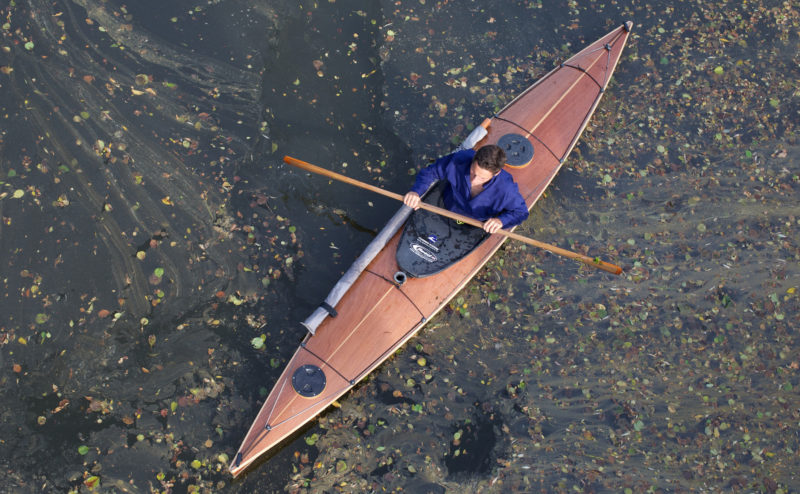
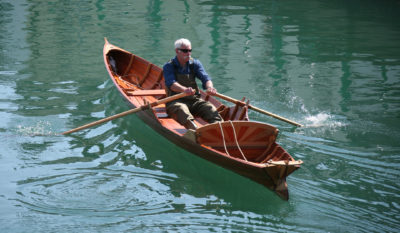
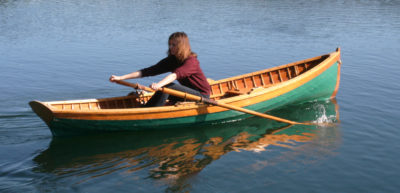
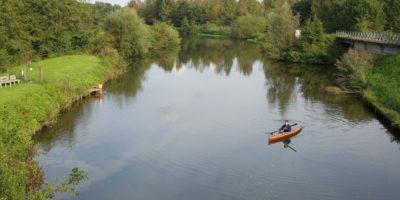
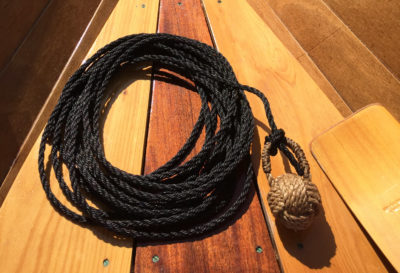
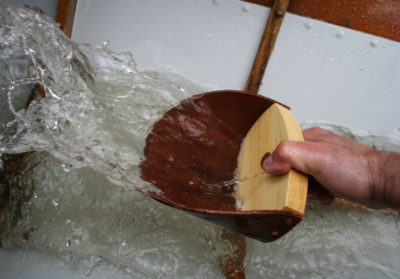
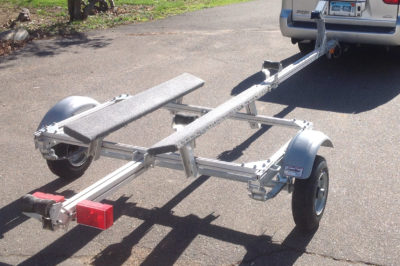
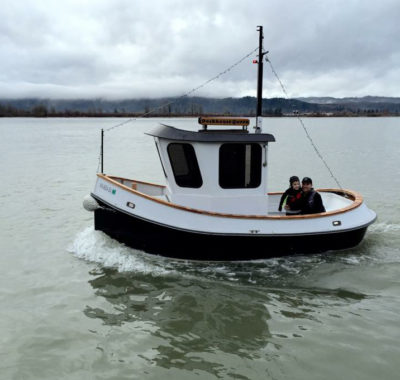
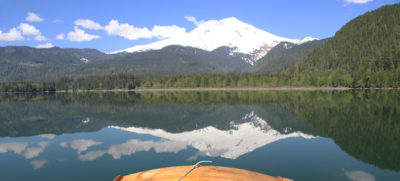
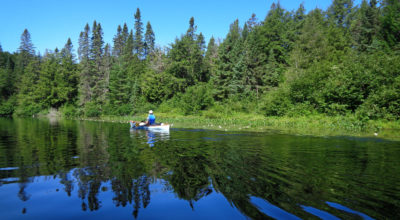
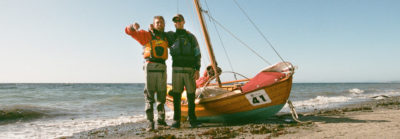
Thanks! The copy of An Inland Voyage we have also has Stevenson’s Travels with a Donkey in the Cévennes, also an excellent read. I wonder how that would be to attempt.
I have always loved this Stevenson book and Donatien and Jean-Marie are to be congratulated on capturing the bohemian spirit once again on their voyage honoring Stevenson’s first go. Fun!